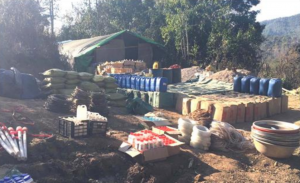Myanmar authorities have seized approximately 18 tons of illicit narcotics in East and Southeast Asia’s biggest-ever drug bust. According to a statement from the United Nations Office on Drugs and Crime, Myanmar police confirmed that they seized that amount of methamphetamines, methyl fentanyl, and “a range of other drugs, key precursor chemicals, and several major illicit drug laboratories and staging areas.”
The operation was the result of a joint operation between the Myanmar police and the Tatmadaw, Myanmar’s military. The operation took place between February 20 and April 9 in Shan State’s Kutkhai Township, UNODC said.
“We are pleased to report the results of the operation with UNODC, and to make it clear to traffickers that their days of operating in Myanmar are numbered,” Colonel Zaw Lin, Head of Law Enforcement of the Myanmar Central Committee for Drug Abuse Control (CCDAC) said, according to UNODC.
“We are meeting our commitments to our Mekong MOU and international partners, and responding to the growing challenge of synthetic drugs facing this country and the region, and we hope our neighbors will take note and work with us, and do the same,” he added.
The operation resulted in the arrest of 33 people, including individuals from outside Myanmar. “What has been unearthed through this operation is truly off-the-charts, and it is clear that a network of production facilities like those found would not be possible without the involvement and financial backing of serious transnational organized criminal groups,” Jeremy Douglas, UNODC Regional Representative for Southeast Asia and the Pacific, said.
“We can today confirm that drug production and trafficking in and through Shan is not what some have been thinking; it is more than meth tablets and crystal, and has evolved to synthetic opioids on a scale nobody anticipated,” Douglas added.
The sites of the operation were at Kaung Kha and Lwe Kham, in North Shan, near the Chinese border. According to the UNODC’s accounting, the seized inventory included “193.55 million tablets (equivalent to 17.4 tons of methamphetamine), over 500 kg of crystal methamphetamine and 630 kg of ephedrine; 3,748.5 liters of methyl fentanyl; 292 kg of heroin, 588 kg of opium and 49 kg of morphine; 6.8 kg of ketamine; and various precursor and pre-precursor chemicals totaling 35.5 tons and 163 thousand litres.”
Myanmar’s remote areas have long been a hot spot for the manufacture of synthetic narcotics that have found their way into markets in Asia and elsewhere in the world. The so-called “Golden Triangle” area of continental Southeast Asia — defined as the region where Thailand, Myanmar, and Laos meet — has long been a prominent narcotics manufacturing and trafficking hub.

































